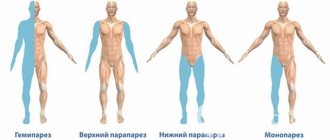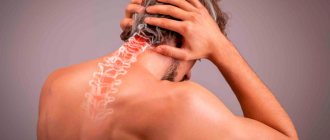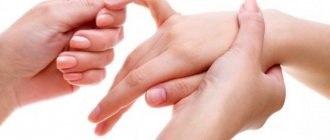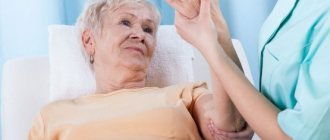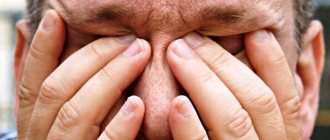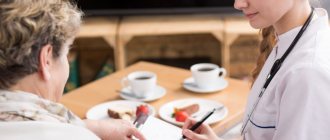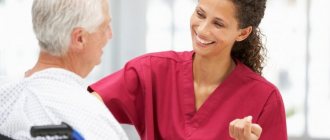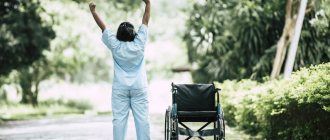The consequences of strokes, in which different hemispheres of the brain are affected, have significant differences and require different therapeutic and rehabilitation measures. If the lesion is in the right hemisphere, then paralysis of the left side of the body occurs. This type of stroke is more difficult to diagnose because the patient remains speechless. In this regard, there is a danger of late diagnosis, so recovery of the left side of the body is more difficult and takes longer. Early diagnosis and treatment are very important: if first aid is provided and the patient is taken to hospital within the first three hours, a stroke can have minimal consequences.
Signs of a right-sided stroke
The leading symptom of a stroke with a lesion in the right hemisphere is paralysis of the left side of the body. The main features are as follows:
- Impaired functioning of the facial muscles. In a right-sided stroke, the left corner of the mouth and the outer corner of the left eye droop.
- The left side is partially or completely paralyzed. There is a dysfunction of the musculoskeletal system and internal organs located on the left side.
As already mentioned, speech disorders are not observed, since the left half of the brain is responsible for this function. For this reason, the diagnosis is often made late, treatment is not prescribed in a timely manner, and the following clinical picture develops:
- Left eye paralysis.
- Hearing impairment.
- Impaired perception of the left side of the body. This may include determining the size of an arm or leg, as well as the distance to them. In addition, the left limbs and fingers do not obey.
If the left side is paralyzed, it means that the blood supply to the right hemisphere, which is responsible for emotions, creative inclinations, abstract thinking, and the integration of accumulated information, is impaired. Therefore, this condition is characterized by the following symptoms:
- Loss of orientation in space, absent-mindedness.
- Memory loss, partial loss of hearing, vision, touch.
- Inexplicable aggression, depressive states, inappropriate reactions and behavior, carelessness.
- Non-perception of colors.
Both hemorrhagic and ischemic strokes are characterized by some common symptoms: impaired consciousness, dizziness, vomiting, sudden headache, and difficulty breathing.
Brain symptoms are more pronounced in hemorrhagic stroke, which is explained by the effect on brain tissue of blood leaking from a burst vessel. The patient experiences severe headaches, sometimes with loss of consciousness, severe nausea, frequent vomiting, and severely impaired consciousness.
Ischemic stroke has less pronounced cerebral symptoms. In this case, neurological manifestations predominate, which depend on the location of the lesion.
If the motor center located in the area of the central gyri of the brain is affected, then paralysis or paresis develops, that is, one or both left limbs may be completely immobilized, or movements may be partially impaired.
If the focus is concentrated in the parietal region, sensory disturbances are observed, in which the sensations of pain, heat, and cold are absent or impaired on the left side.
Paralysis of the left side leads to disturbances in spatial perception. The patient cannot estimate the distance to objects and their sizes, this also applies to his own body. In addition, the perception of time and body diagram is disrupted, the patient ignores the left half of space.
Psychotherapeutic treatment after stroke with left-sided paralysis
You should know that if the right hemisphere of the brain is damaged, left-handers may not experience such signs.
Right-sided stroke in the elderly has its own characteristics due to advanced vascular diseases. This is slow thinking, deterioration of memory and attention, narrowing of the range of interests. Treatment and recovery in this case is difficult and progresses very slowly.
Prevention of recurrent stroke
To prevent stroke and re-stroke, the following prevention recommendations should be followed:
- Pay attention to blood pressure; high levels often cause cerebral hemorrhage.
- If you suffer from hypertension, consult your doctor and choose the appropriate medication. For a better effect of normalizing blood pressure, you can combine taking pills with moderate exercise.
- Spend more time outdoors, walk more often slowly.
- Give up bad habits, they are the main cause of an attack.
- Watch your weight. Excess weight increases the risk of stroke.
- Try to find positive moments, reasons to laugh, be happy, and do what you love.
Difficulties in treatment and recovery after stroke with left-sided paralysis
Patients who have suffered a stroke, which resulted in left-sided paralysis, are passive in relation to rehabilitation measures, since their perception of their own body is distorted. They do not feel motor disturbances, do not strive for recovery, and the period of immobility is more protracted. With such indifference of the patient, rehabilitation is difficult, the recovery period after a stroke is too long, and the effectiveness of the measures is reduced because of this.
For cognitive impairment, nootropil, cerebrolysin, gliatilin, as well as some antidepressants without sedation, such as fluoxetine, imipramine, are prescribed.
Rehabilitation measures after a stroke consist of massages, therapeutic exercises, and physiotherapeutic procedures. Invaluable help can be provided by loved ones who will constantly encourage the patient to undergo treatment. A right-sided stroke requires the mandatory intervention of a psychotherapist.
Treatment of paralysis
- home
- /
- Services
- /
- Treatment of paralysis
There are a large number of diseases and pathologies that can lead to paralysis in a person. This term refers to the complete absence of voluntary movements of the body, associated with the same reasons as paresis. There are several classifications of this condition and methods of its treatment depending on the etiology of its occurrence. Before understanding all these issues, it is worth paying attention to what paralysis is.
Fig.1. What is paralysis
Main causes of pathology
Paralysis is a severe pathological condition, which is characterized by the fact that the muscles of the human body lose the ability to perform their functions. The problem is a consequence of the primary disease. Experts include the following as the main reasons for the development of paralysis:
- strokes;
- tumors in the brain or spinal cord;
- traumatic brain injuries and spinal injuries;
- brain abscesses;
- inflammation of the brain and spinal cord;
- severe poisoning with toxic substances;
- autoimmune neuromuscular diseases;
- epilepsy;
- spinal muscular atrophy.
The condition of a sick person directly depends on what disease led to the pathology. In order for muscle function to be restored, it is necessary to diagnose the patient and draw up a plan for his rehabilitation.
Symptoms of the disease
Paralysis causes a person to experience a complete loss of muscle strength, both in the body and in the limbs. This symptom is the main sign of the disease. As a result of its appearance, the gait changes, the foot hangs down when lifting, the head hangs down, etc.
In the most severe cases, the pathological disorder does not allow the patient to walk or make any movement. A person may stop working the muscle responsible for coordinating the movement of the eyeballs. As a result, strabismus occurs.
Depending on the cause of the pathology, the development of a nasal voice and the appearance of slurred speech may be observed. Every word given to a patient with paralysis comes with great difficulty.
Classification and treatment
All paralysis can be divided into two large groups:
- Central , developing along the pyramidal path at any level without muscle atrophy. This pathology is characterized by the absence of the inhibitory influence of the cerebral cortex. This problem leads to muscle hypotonia, muscle hypertension and a significant increase in reflexes.
- Peripheral , appearing due to the fact that a peripheral motor nerve neuron or group of neurons has been damaged. This type of pathology is characterized by loss of reflexes, hypotension, and degenerative atrophy of muscle fibers.
Sleep paralysis also exists. It occurs before falling asleep or immediately after waking up. This state can last from a couple of seconds to several minutes. It is not pathological and cannot be treated.
Treatment of the disease directly depends on the cause of its occurrence. Patients are recommended to undergo prophylactic mobilization of paralyzed limbs. This helps prevent the occurrence of contractures. The latter limit the voluntary nature of muscle movement due to fixation of the joints in one position.
Another method of therapy is functional electrical stimulation. It prevents the development of muscle atrophy. If complete paralysis occurs due to damage to the central nervous system, doctors recommend that patients use robotic systems. Their work is based on theories of motor learning. One type of such treatment is HAL therapy.
If a patient has a paralyzed part of the body after a stroke, his rehabilitation is carried out through physiotherapeutic procedures. It promotes full or partial restoration of the functioning of the affected half of the body. In some cases, the body can be completely restored to a normal functional state.
LET'S SAY NO TO PARALYSIS!
Nothing is impossible in the world. Often, walking along the streets, we meet children who have difficulty moving on their legs. From time to time we encounter adults with a tucked arm, clenched fingers, or a limping leg. All this happens because the nerve cells that regulate the movement of arms and legs are not developed in the brain (in children), or these nerve cells are destroyed as a result of a stroke (in adults). Often recovery does not occur for many years.
But new, young nerve cells are formed in the brain every day and for some reason do not take on the necessary functions of controlling movement. Doctors at our clinic have been able to find methods that make it possible to direct young nerve cells precisely to those areas of the brain in which their learning occurs and make them do their job. As a result, paralysis disappears and the person begins to walk normally and control his arms and legs. And it doesn’t matter how many years the paralysis lasts. Young nerve cells are always formed at any age. We must force them to perform their functions. We can do it. Come and we will help you.
To restore normal brain function, in our clinic we use:
- Special methods of head and neck massage.
- Various soft techniques of manual therapy of the cervical spine and cranial bones.
To restore lost functions (paralysis of the upper and lower extremities), special methods of training young nerve cells are used. In our work, we are helped by the knowledge that young nerve cells are constantly formed in children and adults, healthy and sick. The nervous system is learning in both young and old people. The main thing is to believe in the colossal possibilities and then success and recovery are guaranteed.
Video of treatment results at Harmony MC
Watch the video before and after treatment at our center.
Result on day 15 of treatment
If you have any questions, call us or sign up for a consultation on the website. We will help you.
Sign up for a consultation
Initial period
The duration of the initial period is 6 months. During this period, basic drug therapy is supplemented with nootropic drugs, vitamin complexes and sedatives. From the moment consciousness is restored, in addition to rubbing with camphor alcohol and frequent turning over, massage of the chest and passive movements of the limbs are carried out. On the third day, breathing exercises are started.
By the end of the first week, the patient is recommended to sit and make active movements of the limbs. The selected exercises must be performed several times a day, the duration of the exercises depends on the patient’s capabilities. You shouldn't do them forcefully. After a few more days, the doctor may allow you to move around.
After 2 weeks, doctors allow you to attend physical therapy classes in the gym. The selected set of exercises is performed slowly and smoothly, while the patient is assisted in this by a trainer. He shows the correct technique for doing the exercises so that you can do them yourself in the future.
What is the danger?
The danger of a stroke lies not in the side of the lesion, but in the vastness of the focus involved in the process of ischemia or hemorrhage. The speed of providing first aid is of great importance: the sooner it is provided, the better the patient’s prognosis for replenishment of lost functions and recovery. The best results are obtained by timely and comprehensive organization of restoration procedures, which are developed in each individual case and complement each other.
The Center for Progressive Medicine “Doctor Pozvonkov” has in its arsenal all the necessary techniques for the multidirectional restoration of a person’s lost motor, sensory, speech and mnestic capabilities. All patients who have suffered a stroke require full rehabilitation, regardless of the location of the lesion. Coordinated interactions with doctors significantly reduce the percentage of disability among victims.
Risk factors for stroke and heart attack
Planning a preventative treatment regimen is based on addressing risk factors that are largely similar for heart attack and stroke.
Metabolic risk factors include:
- dyslipidemia (impaired lipid metabolism - organic compounds, including fats and fat-like substances);
- arterial hypertension;
- obesity;
- metabolic syndrome;
- diabetes mellitus and other endocrinopathies;
- coagulopathies (diseases that develop as a result of disorders of the blood coagulation and anticoagulation systems).
Common markers of heart attack and stroke are:
- previous cardiovascular diseases;
- peripheral vascular pathology;
- calcium index;
- stress test results;
- hypertrophy (thickening of the wall) of the left ventricle.
Atherosclerotic stenosis of the carotid arteries and brain tumors increase the risk of stroke. The provoking factors of a heart attack are:
- atrial fibrillation;
- dysplasia (developmental disorder) of connective tissue;
- arteritis;
- diabetes.
Although the incidence of stroke is higher in men, it is more severe in women, and about half of deaths from stroke occur in women.
Make an appointment
Exercises
As for physical exercises, it is recommended to begin them immediately after the patient’s general condition has stabilized.
At the initial stage, these exercises are performed in a lying position with the help of another person.
So, for example, you should bend and straighten your left arm and leg, and also try to change the position of the fingers that have been paralyzed.
Once the person is able to stand, the exercises will be performed in a standing position.
It is also worth noting that the intensity of physical activity should correspond to the patient’s condition.
Recovery and rehabilitation
In addition to massage and physical activity, the following manipulations will help restore the body’s functioning:
- have a good effect . In this way, sensitivity is stimulated, which speeds up the rehabilitation process;
- Speech therapy and breathing exercises help restore a person’s ability to express thoughts clearly. They consist in communicating with the patient as much as possible;
- Treatment with leeches demonstrates excellent results ;
- Dietary nutrition is important .
First aid
This involves hospitalizing the victim as quickly as possible. To do this, when identifying signs of a stroke, you must first report the incident to the emergency medical service and call a specialized team. It is necessary to provide the patient with rest, a supine position and an influx of fresh air. At home, it is unlikely that anything can be done to prevent the progression of a stroke. Only early initiation of drug therapy or surgery can prevent serious health consequences from a stroke.
Therapy
Treatment of stroke includes basic and specific measures. To begin with, the patient is taken to the intensive care unit and undergoes a course of therapy, the purpose of which is to maintain basic vital functions, including blood circulation, breathing, and also eliminate swelling of the brain.
In the case of ischemic stroke, specific anticoagulant and thrombolytic therapy is carried out. In the case of hemorrhagic damage to the right side of the brain, the treatment, on the contrary, will be aimed at the use of drugs that lead to the formation of blood clots and closure of the bleeding.
Important! Rehabilitation involves undergoing physical therapy, a massage course, taking medications and various physiotherapeutic interventions.
What does recovery depend on?
Factors that reduce the chance of recovery:
- Diseases of the joints of a dystrophic nature;
- Inability to feel your own body;
- Disorders of consciousness and thinking;
- The degree of muscle hypotonia;
- The severity of damage to certain brain structures.
The patient’s complete recovery depends not only on timely assistance and correctly prescribed therapy, but also on how good care is provided. If a person is immobilized due to paralysis, then bedsore prevention is mandatory to avoid deterioration of the general condition and infection. Massage begins from the first days of treatment. The diet must be properly formulated so that the patient receives all the necessary nutrients. If independent food intake is not possible, the patient is fed through a special tube. Moral support and attention from medical staff and relatives are very important. The victim’s apathy or depression should not be perceived as a conscious refusal to help.
Late period
It is a continuation of the initial period and can last up to 6 months. The best option is to continue rehabilitation therapy in a specialized medical facility. The average length of stay is 3 weeks, but may vary depending on the general condition of the patient. There, a psychotherapist always works with the person, and autogenic training is carried out.
Therapeutic gymnastics classes continue with the introduction of new exercises and an increase in the load of physiotherapy - acupuncture, mud therapy and balneotherapy. It helps improve motor performance, delivery of nutrients to muscles and relaxation of the central nervous system.
If the speech defect persists, classes are held with a speech therapist. In a specialized class, they re-teach self-service in everyday life. The classes are aimed at re-learning how to hold a spoon and other skills that the patient could perform without difficulty before the impact.
Rehabilitation is necessary to eliminate apathy and depressive states, leading to the emergence of the will to live.
